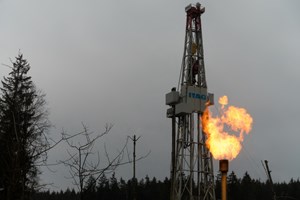Govt. encouraging destruction of environment with offshore gas flaring – Opposition Leader
Jun 11, 2022 -- Source -- Kaieteur News Online -- https://www.kaieteurnewsonline...g-opposition-leader/
Kaieteur News – With a meager US$5 increase added as penalty for the flaring of gas associated with oil production at the Liza One field in the Stabroek Block, Leader of the Opposition, Aubrey Norton has concluded that the People’s Progressive Party (PPP) is encouraging the destruction of the environment.
Norton gave this view on the matter during a press conference hosted on Tuesday.
Opposition Leader, Aubrey Norton addressing the media during his most recent press conference
The Opposition Leader explained that while the laws of Guyana are strong enough to protect the environment, the government has not been enforcing the Constitution to deter the oil and gas operator, ExxonMobil from flaring.
He said, “I believe that having looked at the information, there should be more action to ensure that there is deterrent to flaring. I believe that the laws of Guyana provide for government to ensure that the people get the best they can. I am not convinced that this government is doing everything within the confines of the law to get the best out of the deal but when you are a government that is compromised, you end up in that position”.
The Government of Guyana renewed the Permit for the Liza One operations on May 31 last, ignoring the calls from industry experts to secure a better deal from the oil company first.
In approving the company’s activities, the Environmental Protection Agency (EPA) only effected a few changes to flaring, financial assurance, monitoring and grievance mechanism.
As it relates to flaring, the EPA stated that the new permit “strictly” prohibits” routine flaring and venting; it specifies that flaring is only allowed during commissioning, start-up and special circumstances.
Added to that, the EPA increased the US$45 charge for per tonne of carbon dioxide equivalents (CO2e) emitted as a result of flaring in excess of permitted periods to US$50 per tonne of CO2e.
For the financial assurance provision, EPA stated that the renewed permits ensures “that EEPGL is held liable for all costs associated with clean up, restoration and compensation for any pollution damage which may occur as a consequence of the project.”
It was stated too that the oil company is also required to have financial assurance, which includes a combination of insurance which it was stated must “cover well control, and/or clean up and third-party liability on terms that are market standard for the type of coverage.”
Also, there is a Parent Company/Affiliate Guarantee Agreement which protects and keeps indemnified the EPA and the Government of Guyana in the event of an environmental disaster and EEPGL and its co-venturers fail to meet their environmental obligations under the permit.
However, it was stated that the financial assurance provided must be guided by an estimate of the sum of the reasonably credible costs, expenses, and liabilities that may arise from any breaches of this permit. Notably, liabilities are considered to include costs associated with responding to an incident, clean-up and remediation and monitoring.
In relation to monitoring, the permit makes provision for the targeted monitoring of the effects of waste discharges from the project within the Area of Influence. The effluent streams to be monitored include, but are not limited to, produced water, bilge water, cooling water and grey water.
For the other key provision, the EPA highlighted in its statement that EEPGL is enjoined to establish and maintain a grievance mechanism in keeping with the World Bank’s Approach to Grievance Redress in projects. It was stated that this was done to ensure that complaints from individuals and communities who may be affected by the project are received and addressed. There is also a requirement for reporting same and actions taken to address the grievances to the EPA.
International experts had been lobbying the regulator body to not renew the permit until a better deal is forged for Guyana. For instance, International Lawyer Melinda Janki had recommended that a new Environmental Impact Assessment (EIA) be conducted based in part on the fact that Guyana does have very strong laws in relation to EIAs. She lamented, however, “…those laws are not being implemented or enforced.”
The international lawyer had argued that the Liza I Permit should not be renewed, as the operations pose grave harm to the environment. She had also referenced the miniscule “gains” from the company’s current operations, which far outweighs the damage being caused in the same process.
Tom Sanzillo, Director of Financial Analysis for the Institute for Energy Economics and Financial Analysis (IEEFA), during the recent webinar, had also suggested that the EPA use the Liza 1 permit renewal as leverage to address the numerous shortcomings in the oil contract signed with ExxonMobil in 2016.

